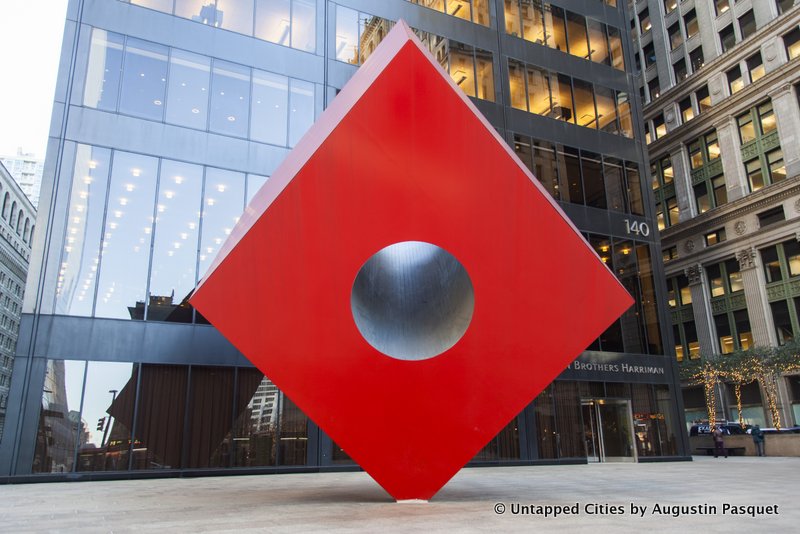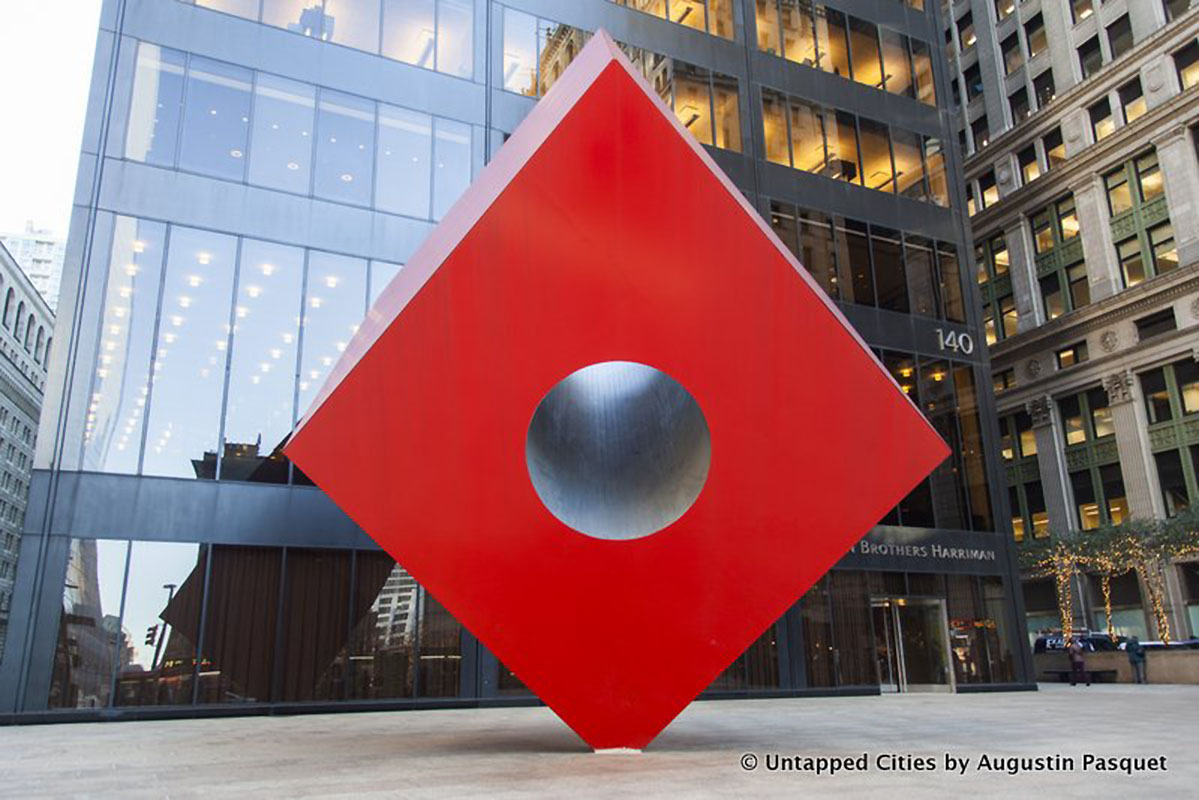At 140 Broadway in Lower Manhattan, Isamu Noguchi’s Red Cube stands out prominently against the backdrop of the soaring Brown Brothers Harriman high rise. Halal carts are frequently parked nearby and adjacent buildings that house HSBC bank and the Bank of America flank the “cube” on its sides. We use the term loosely in this context, as the sculpture is not actually a cube, but a distorted shape seemingly stretched along its vertical axis.
Born in Los Angeles, Isamu Noguchi (1904-1988) was an American artist and industrial designer who is regarded as one of the twentieth century’s most important sculptors. During the span of his career, he crafted gardens, furniture and theater designs, among a number of other works, which can be found in major cities around the world. You’ve undoubtedly seen his work around New York City: the Sunken Garden is located in the open plaza in front of Chase Manhattan Bank Plaza and News decorates the main entrance to 50 Rockefeller Plaza. Moreover, the Isamu Noguchi Garden Museum (now known as The Noguchi Museum) in Long Island City features an outdoor sculpture garden and several galleries of his work.

While his career flourished from the 1920s through to his death in 1988, Noguchi’s initial submissions for the Public Works of Art Program were declined. Red Cube, however, was accepted and installed in 1968.
Like many of Noguchi’s works, the sculpture playfully interacts with the surrounding urban fabric. After all, the site in which a piece is exhibited can be just as important as the sculpture itself. Noguchi, in recognizing this important relationship, once noted: “a sculptor is not merely a decorator of buildings but a serious collaborator with the architect in the creation of significant space and of significant shapes which define this space.”
Alongside the obvious pop of color, you’ll notice that Red Cube is mostly comprised of diagonal lines, while vertical and horizontal lines are seen throughout the surrounding buildings. Crafted from steel, cast in aluminum and painted in red, the sculpture’s most notable feature is a cylindrical hole that runs upward through its center to reveal the building standing behind it. The piece also balances on one corner, with an opposite corner stretching upwards to a height of 24 feet; a viewer’s eye is instantly directed to the sky.
Passerby have compared Red Cube to a rolling die, and interestingly enough, the sculpture does alludes to the “gambling” nature of the surrounding financial markets, according to the Lower Manhattan Cultural Council.
“The cube signifies chance, like the rolling of dice,” Noguchi explained. “If the ‘sun’ [in reference to another Noguchi’s piece, The Garden (Pyramid, Sun, and Cube), at Yale University] is primordial energy, the cube is that man-made pile of carbon blocks by which he had learned to stimulate nature’s processes. The cube on its point may be said to contain both earthly square and solar radiance.”
You can read more about Red Cube in The Life of Isamu Noguchi: Journey without Borders by Masayo Duus. It is also one of the works featured in our upcoming Public Art Tour in Lower Manhattan, which will also look at pieces from American grand masters like Daniel Chester French (as in the Lincoln Memorial in Washington, DC).
On this tour we’ll take a stroll down Broadway and then meander through Battery Park. With each piece, we visit we’ll take the time to deconstruct the image, discuss what is known about it and then share reactions. We’ll be sampling art not only from different eras but also art that has different purposes: propaganda, place-making, reflection, honoring an ideal or group, whimsy, and more. The handicap accessible tour takes about two hours.
Public Art Tour in Lower Manhattan
See our full list of Behind the Scenes NYC Tours.
Next, check out 20 Permanent Outdoor Art Installations in Lower Manhattan and read about other sculptures around New York City. A special exhibit at the Noguchi Museum is also one of our picks for must see art installations and exhibits this month.






